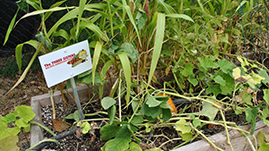Teachers' Domain - Digital Media for the Classroom and Professional Development
User: Preview



Food is personal, cultural, expressive, and essential to our survival. The gardening tradition that adds so much to our quality of life began thousands of years ago as an effort to move away from the uncertainty of hunting and gathering. Human society now depends upon agriculture and, by extension, upon the industries that produce, package, and distribute food. Although most modern people are several steps removed from basic food production, the history of food cultivation is also the history of mankind.
From the earliest North American inhabitants to the gardens of the first colonies to the Victory Gardens of World War II, gardening has played an interesting role in American history. American Indians cultivated corn from grasses and developed planting methods known as the “Three Sisters” with corn, squash, and beans planted as companions; and early American colonists adopted this technique. For those early settlers, the struggles and triumphs of developing gardens were essential to survival. The agricultural practices that they adopted and those that they brought with them from their home countries contributed to the settlement and maintenance of communities in the New World.
Since our nation was founded more than 200 years ago, advancements in knowledge and technology have changed what and how people eat. Food is now available in great abundance, thanks to changes in farming methods such as the introduction of machines for tilling, planting, weeding, and harvesting and the widespread use of commercial fertilizers and pesticides. Innovations in food preservation such as refrigeration and canning have lengthened the shelf life of produce. And our ability to transport agricultural products means that fruits and vegetables from far away places quickly find their way to our grocery shelves.
Researching the food that people commonly ate can teach us a lot about specific historical periods like the Civil War era or the Great Depression. Food is a reflection of human culture and a way to understand how societies interact and trade with each other. And the life cycles and diseases of plants, climate and weather conditions, and sustainable growing practices—all part of the history of food—have directly influenced human migration, politics, and economics.
 Loading Standards
Loading Standards